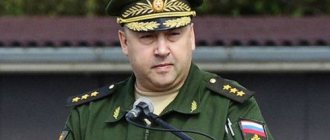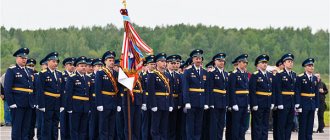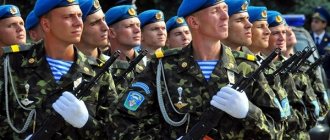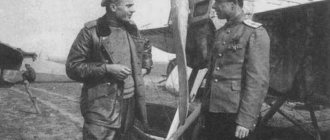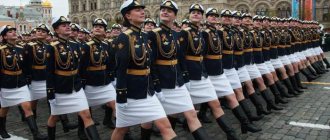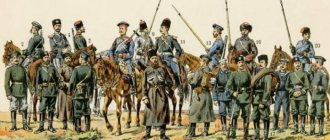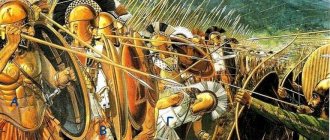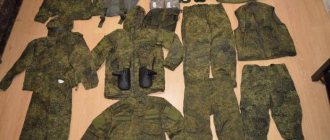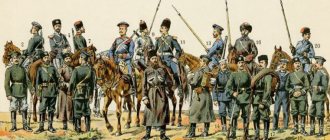The history of the military uniform of the Russian Air Force goes back to Tsarist Russia. Over the century of its existence, the form has changed many times almost beyond recognition. The main historical guidelines in the formation of modern Air Force uniforms are as follows:
- 1910 - formation of the Air Force of the Russian Empire;
- 1918 - creation of the air force of the Russian Soviet Republic;
- 1939 – 1945 - The Great Patriotic War;
- 1945-1990s – Cold War;
- 1992 – reform of the Russian Armed Forces;
- 2009 – introduction of the form created by V. Yudashkin;
- 2013 – Russian Defense Minister S. Shoigu introduced a new Air Force uniform.
Uniforms of the Air Force of the Russian Empire
Initially, aviation was classified as an engineering force. Consequently, the uniforms were engineering ones, although with minor differences - black cloth and silver buttons. The aviation uniform received its own appearance only in 1914, just before the First World War.
The aviator uniforms were brownish in color, and the squad number was indicated by Roman numerals on the epaulettes. Leather jackets and helmets were used for flying. In the summer version, the leather jacket could be replaced with a linen one. The aviators had combat and non-combat uniforms in protective shades at their disposal.
How to get into VKS
To serve as part of such troops, you must meet certain physical and psychological parameters. Here you need to have a high level of responsibility, since mistakes in the operation of military equipment can cost a lot of money or health.
By call
When a citizen of the Russian Federation submits documents to the selection point, it is necessary to indicate the service in the Higher Qualification Service in the application form. The conscript must receive a certificate of complete secondary education. After submitting papers and an interview, a person undergoes a medical examination and psychological tests.
Based on the test results, they are selected for a unit in the aerospace forces. If a person lacks qualifications, he is sent to a training unit for 3 months.
Such soldiers end up in security or utility platoons. Those with appropriate education are sent to more serious departments.
REFERENCE! Good training for the Aerospace Forces is provided by the Military Space Academy named after. F. Mozhaisky and the Military Academy of East Kazakhstan region named after. G.K. Zhukova.
By contract
The contractor must be between 19 and 35 years of age with complete secondary education. Military personnel who have specialized training are sent to the Aerospace Forces troops
Much attention is paid to knowledge of technology. Those who want to serve under a contract apply to the military registration and enlistment office with the following documents:
- university graduation certificate;
- certificate from a narcologist and psychiatrist;
- a certificate from the hospital confirming the absence of diseases;
- biography and characteristics;
- 6 photographs 3 x 4 cm.
IMPORTANT! Military personnel who have been subject to criminal or administrative liability are not accepted into service. After submitting the application, an interview takes place with an employee of the military registration and enlistment office and the head of the unit.
Next, the person undergoes a medical examination and assessment of psychological and physical fitness. If the results are good, the military man is sent to serve in the Aerospace Forces
After submitting the application, an interview takes place with an employee of the military registration and enlistment office and the head of the unit. Next, the person undergoes a medical examination and assessment of psychological and physical fitness. If the results are good, the military man is sent to serve in the aerospace forces.
USSR Air Force uniform
In 1922, Order No. 322 clearly regulated the uniforms of employees of the Workers' and Peasants' Red Army of each branch of the military. At the same time, forty emblems of branches and types of troops were approved, two of which belonged to the air force.
In those days, aviation was not separated into a separate unit of the Armed Forces of the Soviet Union, but was a branch of the Red Army troops. In 1924, the color of the military aviators' uniform was changed to blue. In its cut, the aviator uniform differed little from the uniform of the ground forces. The only difference was the color of the buttonholes and piping - they were blue. Subsequently, the shoulder straps also became blue.
In 1935, Soviet pilots received new buttonholes with a gold field and black piping for political workers, soldiers and junior officers, and blue for officers. On the buttonholes there were insignia - enamel red diamonds, rectangles, squares and rectangles (introduced into use in 1924) and the aviation emblem - a winged propeller.
Also in 1935, gold and red chevrons were introduced. Initially, gold chevrons were intended for generals, and red ones for officers. But in 1940, there was a change in the uniform regulations, as a result of which generals began to wear one wide gold color, emphasized by a red stripe at the bottom. A gold star was placed on top of such a chevron. Officers received chevrons of red and gold stripes.
"Birth" of military aviation
Since the creation of the first aircraft at the turn of the 19th and 20th centuries, the military of all countries paid close attention to the experiments of aviation pioneers. Lighter-than-air aircraft such as balloons and airships, which were widely used during the wars of the second half of the 19th century, have already been tested and shown to be highly effective.
Therefore, as soon as noticeable progress was made in the flight duration and controllability of the aircraft, the military found application for a new type of transport.
The first military aircraft, since 1909, began to be used for surveillance and reconnaissance of enemy positions. The first pilots to use aircraft to attack enemy positions were the Bulgarians during the First Balkan War of 1912-1913, attacking Turkish positions with steel darts and hand bombs. And already by 1915, during the First World War, the history of military aviation opened an account of combat losses suffered by pilots as a result of ground strikes. The “progenitor” of the air defense forces was the Serbian gunner Radoje Lutovac, who shot down an Austro-Hungarian biplane with a captured Turkish cannon.
In just over a hundred years, aviation, and with it the art of flying aircraft, have come a long way. From slow-moving "whatnots" made of wood and fabric that barely reached speeds of 100 km/h and controlled by ropes and pedals, modern military aircraft have reached speeds of MAX 9.1 (more than 9 times the speed of sound), a usage ceiling that allows some fighters ( MIG 25) fly on the border of “near” space - above 37,000 meters. From the use of long-barreled pistols as weapons, with which pilots tried to hit each other when meeting in the sky, and hand grenades, which they threw on the heads of the enemy, modern aviation is armed with the most powerful type of weapon ever created and tested - thermonuclear ( product AN602), known as the “Tsar Bomba” or “Kuzkina Mother”, experiments with which humanity has not dared to repeat since 1961.
The profession of a military pilot is covered with an aura of chivalry, which obsessed the first aces of the First World War, the heroic past of military pilots who participated in two world wars and an innumerable number of smaller local wars. During the Soviet era, two of the three three times Heroes of the Soviet Union were fighter pilots. Military pilots hold the palm in the exploration of outer space and (hypothetical) exploration of extraterrestrial space (landing on the moon???).
Despite the fact that the halo of heroism that surrounded military pilots in the “Golden Age” of aviation - the period between the two world wars - has faded, there are many dreamers who have been striving for the sky since childhood. Those who cannot imagine life without exorbitant speeds and every minute risk.
Air Force uniform from Yudashkin
In 2007, the government allocated 170 million rubles to create a new model of military uniform from Valentin Yudashkin. After two years of development, this form was adopted in 2009. But after existing for three years, in 2012, it was abolished by the decision of Defense Minister Sergei Shoigu. According to his newest project, the uniform of all branches of the military will be similar to the uniform of the Ministry of Emergency Situations employees.
Reform of Sergei Shoigu
The Ministry of Defense announced a decision to reform the standard uniform for command center employees and a new office suit for department employees. In this case, the uniform will be the same for both civilian specialists and military personnel. The uniform will be produced in three colors - black, blue and protective. The color depends on the specific type or branch of the military. The uniform is designed exclusively for everyday wear, and not for field conditions.
Air Force uniform for today
Uniforms for cadets and enlisted personnel
The summer version of the office uniform consists of a blue suit, a white T-shirt, a field cap, black high-top boots, black socks and a field cap. The winter version of the office uniform consists of a camouflage suit and T-shirt (T-shirt), a muffler and protective coat, a camouflage field cap, black boots or low shoes with black socks and camouflage gloves. In service, the uniform is completed with a black belt. Stripes on summer military uniforms are always placed on the left sleeve, on the outside. Stripes should only be placed on the jacket or coat.
Officer's uniform
The summer casual uniform consists of a blue jacket and trousers, and a blue shirt. Under the shirt goes a black tie with the obligatory gold tack. A blue or protective cap serves as a headdress. Shoes are required in black boots, low shoes or ankle boots with black socks. The uniform for the form is equipped with a black belt.
In winter, the uniform of Air Force officers consists of trousers and a blue or khaki jacket. Under the suit, a khaki or blue shirt with a black tie and gold pin is required. The outerwear is a gray or blue coat with a gray hat with earflaps. Gloves must be black. Under the coat - a protective or blue muffler. Shoes – low shoes, shoes or boots with black socks. The uniform for the formation is complemented by a black belt.
The charter allows the wearing of caps, caps or berets, raincoats and jackets in khaki or blue. In the winter version of the uniform, instead of a jacket, you can wear a blue or khaki sweater.
Senior officers uniform
The main difference between the winter uniform of senior officers is the presence of a gray astrakhan detachable collar and a gray hat.
Uniform for female military personnel
The summer casual uniform of female military personnel consists of a skirt and jacket in blue or khaki, a blouse in khaki or blue, and a tie with a gold tack. As a headdress - a blue or protective cap. Shoes – shoes or boots of black or flesh color.
The winter office uniform is complemented by a khaki or blue muffler and a khaki coat. Headdress – gray astrakhan beret. The coat colors of officers and warrant officers are blue and gray.
Uniforms of Red Army pilots from 1935 to 1943
By 1935, most of the military personnel who served in the Civil War had either retired or achieved significant military positions. In the memory of the younger generation there was no acute rejection of senior military leaders as representatives of the ruling class. The mistakes of the abolition of military ranks in the Red Army were realized.
In 1935, military reform was carried out and military ranks for the command staff of the Red Army were partially restored. The first 5 marshals appeared. The most junior officer rank was junior lieutenant. Differences in military ranks and positions were indicated by insignia worn on buttonholes (epaulettes were still hated) and sleeve patches.
By 1935, Soviet aviation occupied a leading position. Aircraft capable of intercontinental flights were created. The prestige of a military pilot was at the highest level in the entire history of the Air Force.
The developers of the new uniform for the air force did not skimp on the variety of sets of clothing and its styles (design). The range of clothing sets for officers and enlisted personnel was expanded. Significant differences appeared in the cut, quality of materials and terms of wearing. Wearing shoes was ranked:
- chrome boots - for all officers;
- yuft ones - for petty officers and non-commissioned officers (command personnel - in the terminology of the Red Army);
- cowhide or tarpaulin - for privates.
Officer's uniform of the 1935-1941 model. included two sets.
Summer set:
- Double-breasted overcoat (lightweight cloth);
- Cap or cap;
- Summer tunic (military field);
- Cotton or cloth breeches for tuning;
- French ceremonial weekend;
- Trousers for formal-weekend graduation;
- White shirt;
- The tie is black;
- The gloves are white;
- Chrome boots or boots with leggings;
- Boots are black or brown for dress uniforms.
Figure 3
Summer ceremonial and weekend set
Winter set:
- Double-breasted overcoat black and white;
- Cloth helmet (Budenovka type);
- French p/sh;
- Tunic, p/sh;
- Breeches-breeches p/sh;
- Chrome boots or insulated boots (with leggings);
- Gloves (brown).
Figure 4
Winter set
In addition to summer and winter uniforms, military pilots and crew members (flight personnel) were equipped with special clothing: long leather coats with fur, leather helmets with fur, high boots, leggings, fur gloves, flight jackets (with a detachable fur lining), various types of underwear linen made of pure wool, polyester and cotton fabric.
The pilots had silk scarves as part of their flight uniform. This is not foppishness, but a practical necessity. During air combat, the pilot had to turn his head hundreds of times. Any fabric other than silk would chafe the neck and incapacitate the pilot. Therefore, a silk scarf was a distinctive feature of a military pilot (not only in the Red Army, but also in the armies of other countries).
Particular attention was paid to the insignia of senior, senior, middle and junior command personnel. Only the color of the buttonholes and edging remained unchanged - blue:. Figure 5
Figure 5
Insignia of the senior command staff of the Air Force Red Army 1935-1943.
Figure 6
Insignia of senior command staff of the Air Force Red Army 1935-1943.
Figure 7
Insignia of junior command staff of the Air Force Red Army 1935-1943. and privates
Air Force dress uniform
Uniforms for cadets and enlisted personnel
The summer dress uniform of enlisted personnel consists of a blue or khaki suit, underneath which is a khaki shirt and a black tie with a gold tack. A khaki woolen cap serves as a headdress. Shoes – black boots or low shoes with black socks.
The winter dress uniform of enlisted personnel, in addition to a suit and shirt, includes a khaki coat and muffler, a gray fur hat with earflaps and black gloves. In summer, instead of a cap, it is permissible to wear a beret. In winter it can be used instead of a hat.
Officer uniform
The summer version of the officer's uniform consists of a blue jacket and trousers, a white shirt with a black tie and a gold pin. The cap must match the color of the suit. Shoes – black boots or low shoes with black socks. For construction, a golden belt is worn.
The winter ceremonial officer uniform is complemented by a gray or blue coat, a white muffler and black or white gloves. The headdress is a gray fur hat with earflaps. Shoes – black shoes, low shoes or boots. Berets or outerwear in blue or khaki colors are allowed to be worn.
The ceremonial uniform of senior officers is, in general, the same as that of other officers. The difference is a gray patched astrakhan collar and a gray hat.
Uniform for female military personnel
Summer ceremonial clothing for female enlisted military personnel does not differ from everyday clothing. The outer suit of warrant officers and officers is blue. Underneath is a white blouse. The uniform for the formation is complemented by a black belt for rank and file and a golden belt for officers.
The winter version of the officers' dress uniform is complemented by a white muffler; the colors of officer coats are gray and blue. The officer's skirt and jacket are blue, the blouse is white, and that of the rank and file is protective. Soldiers and cadets wear khaki coats. Headdress – gray astrakhan beret. The uniform for the formation is complemented by a belt, black for rank and file, golden for officers and warrant officers.
Video about the Air Force
New collar buttonholes for office uniforms were introduced into the military this year
Today we will talk about new “coil” buttonholes for military officers.
As reported by a number of publications, the Ministry of Defense of the Russian Federation has already developed and plans to introduce in the near future new lapel emblems that resemble the insignia of the Russian Guard of the 19th century. This buttonhole among the officers received an unspoken name - “reel”
Read about whether there will be an increase in the length of service bonus for military personnel in 2022
and what salaries await us for military personnel in 2022!
The new buttonholes will be located on the corners of the collars of jackets, casual suits (office uniforms) and casual shirts, and these insignia will be introduced exclusively for officers of the RF Armed Forces.
How to correctly place buttonholes on officers' office uniforms
Buttonholes for officers - a sign of belonging to the officer corps
For officers (except for senior officers and officers of the Navy) in the form of a historical golden buttonhole on protective cloth - for officers of the Ground Forces, and for officers of the Air Force, Aerospace Forces and Airborne Forces - blue.
Placement and wearing of buttonholes on office uniforms
The buttonholes are placed on the “office” in pairs on the lower part and along the edge of the collar of the office uniform. Parallel to the line of departure and cut of the collar. You also need to remember that the color of the threads must match the color of the cloth of the buttonhole.
This is what the new buttonholes for officers' office uniforms look like
The overall size of the buttonhole is 22 by 32 mm. Along the entire perimeter of the buttonhole, at a distance of 2 mm from the edge, there are edgings of a protective color (blue for the Air Force, VKS and Airborne Forces).
Edge width - 1mm. The height of the historical buttonhole is 24 mm.
The width of the historical buttonhole at its widest point is 16 mm, at its narrowest point - 8.5 mm.
New collar tabs for Navy officers' office uniforms
For officers of the Navy (except for senior officers of the Navy) - in the form of golden anchors.
Overall size 31 by 37 mm. There are black edgings along the perimeter of the buttonhole at a distance of 2 mm from the edge.
Edge width - 1mm. Anchor height - 34 mm. Width - 22 mm.
Coil buttonholes on office uniform
How and where exactly these coil buttonholes will be worn on the uniform will be announced later.
Since work has currently been organized to amend the Order of the Minister of Defense of the Russian Federation dated June 22, 2015 No. 300 “On approval of the rules for wearing military uniforms, insignia, departmental insignia and other heraldic signs in the Armed Forces of the Russian Federation and the Mixing Order items of existing and new military uniforms in the Armed Forces of the Russian Federation"
And we must assume that in the near future all officers of the Russian Army will wear new-style buttonholes on their office uniforms.
